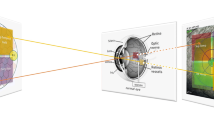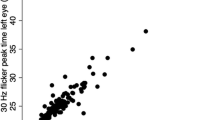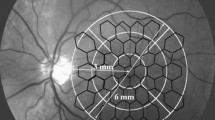Abstract
Purpose
To study the relationship between foveal thickness assessed by optical coherence tomography (OCT) and foveal function measured with multi focal electroretinography (mfERG) in patients with non-proliferative diabetic retinopathy, and with no previous laser treatment.
Methods
Twenty-six eyes from 18 diabetic patients (13 men), aged 59 years, (range 28–79 years), diabetes duration 15 years, (range 2–27 years), with a macular thickness between 200 and 600 μm were evaluated by mfERG, visual acuity (ETDRS score) and OCT. Mean amplitudes and implicit times of the mfERG responses were analyzed within the four innermost (14 degrees) of the six concentric rings. For comparison with the results from the OCT (diameter of measured area = 6 mm) we analyzed the summed response from the first and second ring (central zone), corresponding to the central area of the OCT. The third(zone 2) and fourth (zone 3)of the four innermost of the six concentric rings measured by the mfERG corresponding to the second and third area of OCT.
Results
An increased macular thickness in the central area of the OCT correlated to reduced amplitudes (r = −0.541; P = 0.004) and prolonged implicit times (r = 0.548; P = 0.004) in the central zone of the mfERG, and inversely correlated with visual acuity, −0.49; P = 0.045.
Retinal thickness in the second area was correlated to prolonged implicit times in the second mfERG zone (r = −0.416; P = 0.034). No correlations were found for the third area of the OCT. When macular thickness exceeded 300 μm the decrease of amplitudes and prolonged implicit times, measured by mfERG, seemed to be more pronounced.
Conclusion
In conclusion increased macular thickness is correlated with reduced amplitudes and prolonged implicit times on the mf ERG and worse visual acuity.




Similar content being viewed by others
References
Moss SE, Klein R, Klein BEK (1994) Ten-year incidence of visual loss in a diabetic population. Ophthalmology 101:1061–1070
Early Treatment Diabetic Retinopathy Study Research Group (1985) Photocoagulation for diabetic macular oedema. ETDRS report number 1. Arch Ophthalmol 103:1796–1806
Hee MR, Puliafito CA, Wong C et al (1995) Quantitative assessment of macular oedema with optical coherence tomography. Arch Ophtalmol 113:1019–1029
Hee MR, Puliafito CA, Duker JS et al (1998) Topography of diabetic macular oedema with optical coherence tomography. Ophtalmology 105:360–370
Otani T, Kishi S, Maruyama Y (1999) Patterns of diabetic macular oedema with optical coherence tomography. Am J Ophtalmol 127:688–693
Brown et al (2004) Detection of diabetic foveal oedema: contact lens biomicroscopy compared with OCT. Arch Ophtalmol 122:330–335
Sánchez-Tocino H, Alvarez-Vidal A, Maldonado MJ et al (2002) Retinal thickness study with optical coherence tomography in patients with diabetes. Invest Ophthalmol Vis Sci 43:1588–1594
Agardh E, Stjernquist H, Heijl A et al (2006) Visual acuity and perimetry as measures of visual function in diabetic macular ooedema. Diabetologia 49:200–206
Henricsson M, Heijl A (1994) visual fields at different stages of diabetic retinopathy. Acta OPhthalmol 72:560–569
Ong GL, Ripley LG, Newsom RS et al (2004) Screening for sight-threatening diabetic retinopathy: comparison of fundus photography with automated colour contrast threshold test. Am J Ophtalmol 137(3):445–452
Ong GL, Ripley LG, Newsom RS, Casswell AG (2003) Assessment of colour vision as a screening test for sight threatening diabetic retinopathy before loss of vision. Br J Ophthalmol 87(6):747–752
Ghafour IM, Foulds WS, Allan D, McClure E (1982) Contrast sensitivity in diabetic subjects with and without retinopathy. Br J Opthalmol 66:492–495
Sutter EE, Tran D (1992) The field topography of ERG components in man. I. The photopic luminance response. Vision Res 32:433–446
Greenstein VC, Holopigian K, Hood DC et al (2000) The nature and extent of retinal dysfunction associated with diabetic macular oedema. Invest Ophthalmol Vis Sci 41:3643–3654
Marmor MF, Hood DC, Keating D et al (2002) Guidelines for basic multifocal electroretinography (mfERG) (for the International Society for Clinical Electrophysiology of Vision). Doc Ophthalmol 106:105–115
Lövestam-Adrian M, Andreasson S, Ponjavic V (2004) Macular function assessed with mfERG before and after panretinal photocoagulation in patients with proliferative diabetic retinopathy. Doc Ophthalmol 109:115–121
Bearse MA Jr, Sutter EE (1996) Imaging localized retinal dysfunction with the multifocal electroretinogram. J Opt Soc Am A 13:634–640
Yamamoto S, Yamamoto T, Hayashi M, Takeuchi S (2001) Morphological and functional analyses of diabetic macular oedema by optical coherence tomography and multifocal electroretinograms. Graefe´s Arch Clin Exp Ophthalmol 239:96–101
Ma J, Yao K, Jiang J, Wu D, Gao R, Yin J, Fang X (2004) Assessment of macular function by multifocal electroretinogram in diabetic macular edema before and after vitrectomy. Documenta Ophtalmologica 109:131–137
Bearse MA Jr, Adams AJ, Han Y, Schneck ME, Bronson-Castain K, Ng J, Barez S (2006) A multifocal electroretinogram model predicting the development of diabetic retinopathy. Prog Retin Eye Res 25:425–448
Chylack LT Jr, Wolfe JK, Singer DM et al (1993) Longitudinal study of the cataract study group. The lens opacities classification system (LOCS) III. Arch Ophthalmol 111:831–836
Early Treatment Diabetic Retinopathy Study Research Group (1991) Early photocoagulation for diabetic retinopathy: ETDRS report number 9. Ophthalmology 98:766–785
Kang SEW, Park CY, Ham D (2004) The correlation between fluorescein angiographic and optical coherence tomographic features in clinically significant diabetic macular oedema. Am J Ophthalmol 137:313–322
Francois J, de Rouck A, Cambie E, Castanheira-Dinis A (1977) Electrophysiological studies before and after argon-laser photocoagulation in diabetic retinopathy. Ophthalmologica 176:133–144
Early Treatment Diabetic Retinopathy Study Research Group (1987) ETDRS No 4. Photocoagualtion for diabetic macular oedema. Int Ophthalmol Clin 27:265–272
Antonio P, Del Borrello M, Polini G, Furlan F, Isola M, Bandello F (2006) Diurnal variation in clinically significant diabetic macular edema measured by the stratus OCT. Retina 26:14–20
Bengtsson B, Heijl A, Agardh E (2005) Visual fields correlate better than visualacuity to severity of diabetic retinopathy. Diabetologia 48:2494–2500
Breton ME, Quinn GE, Keene SS et al (1989) Electroretinogram parameters at presentation as predictors of rubeosis in central retinal vein occlusion patients. Ophthalmology 96:1343–1352
Larsson J, Andreasson S (2001) Photopic 30 Hz flicker ERG as a predictor for rubeosis in central vein occlusion. Br J Ophthalmol 85:683–685
Seiple W, Vajaranant TS, Szlyk JP et al (2003) Multifocal Electroretinography as a function of age: The importance of normative values for older adults. Invest Ophthalmol Vis Sci 44:1783–1792
Schatz P, Holm K, Andreasson S (in press) Retinal function after scleral buckling for recent onset rhegmatogenous retinal detachment. Retina
Acknowledgements
This study was supported by grants from the Medical Faculty, Lund University, the Skane County Council Foundation for Research and Development, the Crown Princess Margareta`s Committee for the Blind and the 2nd O.N.C.E. international award for new technologies for the blind.
Author information
Authors and Affiliations
Corresponding author
Rights and permissions
About this article
Cite this article
Holm, K., Larsson, J. & Lövestam-Adrian, M. In diabetic retinopathy, foveal thickness of 300 μm seems to correlate with functionally significant loss of vision. Doc Ophthalmol 114, 117–124 (2007). https://doi.org/10.1007/s10633-006-9044-7
Received:
Revised:
Published:
Issue Date:
DOI: https://doi.org/10.1007/s10633-006-9044-7




